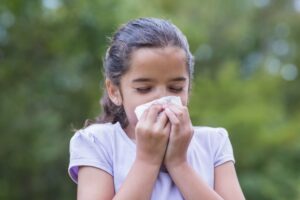June 06, 2024 | Black & Kletz Allergy

There are many types of grasses and they are categorized by what family and subfamily of grasses they encompass. In the grass family Poaceae, there are several subfamilies that contain highly allergenic grasses. Pooideae is the largest subfamily of the grass family Poaceae. The common grasses associated with this subfamily include Orchard, Timothy, Kentucky blue, Sweet vernal, Red top, Meadow fescue, and June grasses. The common cereal grasses (e.g., rye, barley, oat, wheat) are also members of the grass family Poaceae. Panicoideae is a subfamily of Poaceae too and is comprised of many grasses with the most notable allergenic grasses being Bahia and Johnson grasses. Chloridoideae is also a subfamily of Poaceae and the most allergenic grass from this subfamily is Bermuda grass. Bermuda grass, however, tends to grow and pollinate primarily in the Southern U.S. where there are warmer temperatures.
The classic symptoms that an allergic individual who has allergic rhinitis (i.e., hay fever) to grass pollen may experience are the same symptoms that one would experience with any other pollen, dust mite, mold, or pet allergy. The characteristic symptoms may include sneezing, runny nose, nasal congestion, post-nasal drip, itchy nose, itchy throat, snoring, hoarseness, sinus headaches, sinus congestion, itchy ears, clogged ears, itchy eyes, watery eyes, redness of the eyes, puffy eyes, chest tightness, wheezing, coughing, and/or shortness of breath. In allergic individuals who are very allergic, contact with grass may cause hives and itchy skin. It should be noted that in extreme cases, it has been reported that very sensitive grass-allergic individuals can develop anaphylaxis upon scraping their skin with grass. This unusual anaphylactic reaction tends to occur while playing certain sports that are played on grass such as soccer, football, and baseball.
In addition to the above allergic rhinitis symptoms, some individuals with grass pollen allergies may experience itching of the mouth, throat, tongue, and/or lips due to a reaction to a protein in certain fresh fruits, vegetables, and/or nuts. The protein in the fresh fruits, vegetables, and/or nuts looks very similar to the allergenic protein found in grass pollen. The most common fruits and vegetables that cause these symptoms in grass-allergic individuals include melons (e.g., cantaloupe, honeydew, watermelon), tomatoes, and potatoes. These individual’s immune systems “see” the protein in these foods as the same protein found in grass pollen even though they are not actually the same proteins. As a result, the grass-allergic patient reacts to the food proteins because it is so similar to the grass pollen protein. This condition is called oral allergy syndrome or pollen food allergy syndrome. Note that if the food is cooked (i.e., heated), the protein of the food is denatured (i.e., broken down), and as a result, the individual can tolerate the food without having the mouth, throat, tongue, and/or lips symptoms. It is also interesting to note that oral allergy syndrome also occurs in individuals with tree pollen and ragweed pollen allergies.
The diagnosis of grass pollen allergy begins with a board certified allergist like the ones at Black & Kletz Allergy performing a comprehensive history and physical examination from the patient. Allergy skin testing or blood testing is usually done in order to identify specific allergens as the cause of the allergy symptoms. Pulmonary function tests may also be performed if one’s symptoms are indicative of asthma or the patient has a history of asthma.
The treatment of grass allergies begins with prevention and avoidance. The patient should try to avoid contact with grass by minimizing yardwork and lawn mowing, if possible. Removing one’s clothing and shoes when coming indoors after being outside may be helpful. Taking a shower after being outdoors for a prolonged period of time is also recommended. Wiping down or washing the fur of one’s pets after they are outside is also suggested.
Medications are usually the next step in the treatment of grass pollen allergy. Oral medications may include antihistamines, decongestants, and leukotriene antagonists. Nasal medications may include corticosteroids, antihistamines, and anticholinergics. Ocular medications may include antihistamines, decongestants, and mast cell stabilizers. Ocular corticosteroids are only used for severe ocular allergy symptoms due to the potential for long-term side effects. Oral corticosteroids may also be utilized but again reserved for recalcitrant and difficult to treat allergy symptoms. As with ocular corticosteroids, oral corticosteroids can also cause long-term side effects and are used judiciously.
Allergy immunotherapy (i.e., allergy shots, allergy injections, allergy desensitization, allergy hyposensitization) is often used to treat pollen allergies as well as dust mite, mold, and pet allergies. They are effective in 80-85% of the patients who take allergy shots. The average length of time on allergy immunotherapy is typically 3-5 years.
The board certified allergists at Black & Kletz Allergy have 3 offices in the Washington, DC, Northern Virginia, and Maryland metropolitan area and treat both children and adults with grass allergies. We have offices in Washington, DC, McLean, VA (Tysons Corner, VA), and Manassas, VA. Black & Kletz Allergy offers on-site parking at each of their 3 office locations and the Washington, DC and McLean, VA offices are also Metro accessible. There is a free shuttle that runs between our McLean, VA office and the Spring Hill metro station on the silver line. To make an appointment, please call our office or you can click Request an Appointment and we will respond within 24 hours on the next business day. Black & Kletz Allergy has been serving the allergy and asthma needs of the Washington, DC metro area community for more than 5 decades and we strive to offer high quality allergy and asthma care in an empathetic and professional atmosphere.












